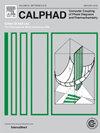High-throughput determination of interdiffusivities and atomic mobilities in Fcc Co-Ni-V alloys
IF 1.9
3区 材料科学
Q4 CHEMISTRY, PHYSICAL
Calphad-computer Coupling of Phase Diagrams and Thermochemistry
Pub Date : 2025-01-04
DOI:10.1016/j.calphad.2024.102796
引用次数: 0
Abstract
Accurate diffusion kinetics of Co-Ni-V medium entropy alloys can guide alloy composition and process design, facilitating further exploration of their performance potential. Totally twelve diffusion couples close to the Co-Ni binary side were assembled, and their composition profiles were measured by EPMA to determine the diffusivity of Fcc Co-Ni-V alloys at 1273, 1373 and 1473 K. The interdiffusivities along the whole composition profiles and the atomic mobilities of Fcc Co-Ni-V alloys were evaluated by the numerical inverse approach incorporated in CALTPP program (CALculation of ThermoPhysical Properties). The obtained interdiffusivities were further compared with those calculated by the Matano-Kirkaldy method, which can accurately determine the diffusivities at the intersection compositions of two diffusion paths. Meanwhile, the model-predicted composition profiles and diffusion paths of Co-Ni-V alloys show good agreements with the experimental ones, validating the accuracy of the presently obtained atomic mobilities. Furthermore, the presently assessed atomic mobility parameters coupled with thermodynamic description of Fcc Co-Ni-V alloys were applied in calculating interdiffusivities, activation energies and frequency factors.
Fcc Co-Ni-V合金中扩散系数和原子迁移率的高通量测定
准确的Co-Ni-V中熵合金扩散动力学可以指导合金成分和工艺设计,有利于进一步挖掘其性能潜力。在1273、1373和1473 K温度下,组装了12对靠近Co-Ni二元侧的扩散偶,用EPMA测量了它们的成分分布,测定了Fcc Co-Ni- v合金的扩散系数。采用CALTPP程序(计算热物理性质)中的数值反演方法对Fcc Co-Ni-V合金在整个组成剖面上的扩散系数和原子迁移率进行了计算。将所得的扩散系数与Matano-Kirkaldy方法计算的扩散系数进行比较,可以准确地确定两条扩散路径相交组成处的扩散系数。同时,模型预测的Co-Ni-V合金的成分分布和扩散路径与实验结果吻合较好,验证了目前得到的原子迁移率的准确性。此外,结合Fcc Co-Ni-V合金的热力学描述,利用目前评估的原子迁移率参数计算了Co-Ni-V合金的扩散系数、活化能和频率因子。
本文章由计算机程序翻译,如有差异,请以英文原文为准。
求助全文
约1分钟内获得全文
求助全文
来源期刊
CiteScore
4.00
自引率
16.70%
发文量
94
审稿时长
2.5 months
期刊介绍:
The design of industrial processes requires reliable thermodynamic data. CALPHAD (Computer Coupling of Phase Diagrams and Thermochemistry) aims to promote computational thermodynamics through development of models to represent thermodynamic properties for various phases which permit prediction of properties of multicomponent systems from those of binary and ternary subsystems, critical assessment of data and their incorporation into self-consistent databases, development of software to optimize and derive thermodynamic parameters and the development and use of databanks for calculations to improve understanding of various industrial and technological processes. This work is disseminated through the CALPHAD journal and its annual conference.

 求助内容:
求助内容: 应助结果提醒方式:
应助结果提醒方式:


